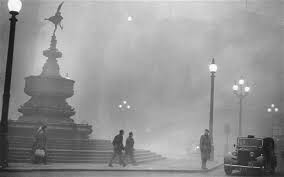It was, by all means, just another early December day in 1952 London. There was a heavy smog cast over the city that lasted four days, till 9th December, but the citizens were used to that kind of weather. Nobody thought very much of it at all, until the following weeks where government reports calculated that between 5th and 8th December, there had been at least 4000 premature deaths, while around 100,000 people fell ill due to what is now referred to as the ‘Great Smog of 1952’.
On the 4th of December, an anticyclone hung over London, due to which the smoke coming out of chimneys, instead of dispersing into the atmosphere as it usually did, got pushed down, warming the air as it descended. As a result, an inversion was created, which is when the air closer to ground is cooler than the air above it, contrary to regular conditions. Back in the ‘50s, central heating (using gas, electricity, oil, or permitted solid fuel) was not very common. Most households burned coal to keep warm, and the temperature drop on the first day of the Great Smog only caused an increase in the quantity of coal being combusted. Aside from smoke from houses, the gases released by power stations and factories also got trapped by the inversion, as did vehicular exhausts. Even pollution that winds had carried to London from the east got combined with this deadly mixture, which fused with the existing fog to form thick and lethal smog.
Smog is characteristically pungent and has a dirty-yellow or brown colour, unlike fog, which is clean and white. Reports claim that thick smog had blanketed London earlier too, in the years 1813, 1873, 1880, 1882, 1891, 1892 and 1948, and marked increases in death rates followed. The East End of London usually suffered the worst effects; it had a high density of houses and factories, in addition to which it was low-lying, which made it difficult for the fog to disperse.
On each day that the Great Smog of 1952 lasted, the pollutants released included 1,000 tonnes of smoke particles, 2,000 tonnes of carbon dioxide, 140 tonnes of hydrochloric acid, 14 tonnes of fluorine compounds, and, most dangerously, 370 tonnes of sulphur dioxide that were converted into 800 tonnes of sulphuric acid.
The better quality ‘hard’ coals were exported from London for economic purposes, so the coal used in houses was of a low-grade sulphurous variety that released large amounts of sulphur dioxide into the air. This pollutant along with some other harmful constituents in the air triggered asphyxiation in a large number of people. In particular the diesel-fuelled buses that had replaced the recently abandoned electric tram system released numerous polluting substances.
No panic was prevalent during the foggy period, but the city was practically shut down because the smog greatly affected visibility in the city. Fog even invaded indoor areas. On the first night, visibility dropped to a few metres, and in the following days, the fog further thickened. In some regions, people couldn’t see their feet, or even their hands in front of them. Pedestrians could not find their way at night even in familiar neighbourhoods. Outdoor sports events, theatres and concerts were abandoned or cancelled. Public transport was brought to a halt, although the London Underground continued to function. Ambulance services ceased too, forcing people to secure their own means of transport to hospitals.
Reports declared that a large percentage of the people who were affected or killed by the smog were very young or elderly, or had existing respiratory problems. In many people, the smog caused respiratory problems. The smog either caused lung infections which resulted in the formation of pus that blocked the air passages, or respiratory infections from hypoxia. The lung infections caused were mainly bronchopneumonia or acute purulent bronchitis superimposed upon chronic bronchitis. It was not just humans but also cattle that were asphyxiated by the smog.
Although earlier the reports had estimated the death toll to be 4,000, recent studies indicate a considerably higher death toll of around 12,000. Hence the Great Smog of 1952, also known as the Great Smoke is considered to be the worst air-pollution event in the history of the United Kingdom, and the most significant in terms of its effect on public awareness and government regulation of air quality.
This high death count shocked people of London and of the world to take action and start the environmental movement. The life-threatening potential of the smog had been revealed. Changes in practice and regulation followed the Great Smoke. Many laws were introduced to prevent a repeat of the situation. Clean Air Acts were passed by the Parliament in 1956 and 1968 which banned the emission of black smoke by households or by factories. Financial incentives were extended to people who replaced open coal fires with coke, which produces negligible amounts of smoke, or other alternatives such as gas fires. Despite the improvement that these actions brought about, another smog event occurred in 1962, although fortunately that was of a much smaller scale, resulting in only 750 deaths. Modern developments such as the spread of central heating and changes in pollution legislation have ensured that such incidents do not occur again.

Leave a Reply